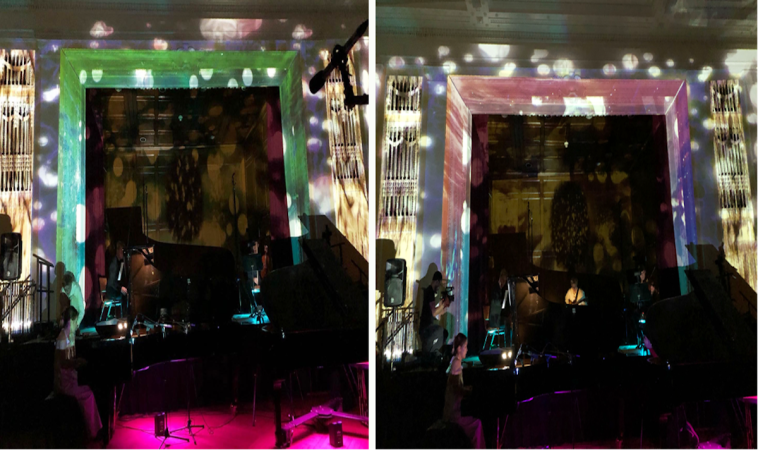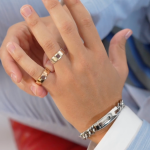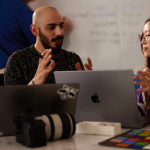Haran Kim, a notable figure in the integration of technology and traditional art, has carved a distinctive path through the artistic landscape. Her educational background from Carnegie Mellon University and Indiana University Bloomington has provided a strong foundation for her ventures into the realms of Virtual Reality (VR), Augmented Reality (AR), and 3D modeling.
Her career spans a variety of pioneering experiences and roles, from her beginnings as a technical artist at Calman Incorporated to influential collaborations like the Amity Trio Project and Bloomingsongs. Kim’s journey is marked by her continual push against the conventional boundaries of art.
In a conversation with Haran Kim, her journey unfolds, highlighting her approach to blending technology with art. Her insights reveal a deep understanding of digital creativity’s evolving nature. Kim’s story reflects not just her personal growth but also the broader evolution of the art world, where technology emerges as a new platform for creative expression.
Hello, Haran. We’re so excited to have you! We’re curious – how have your experiences in traditional printmaking and fine arts influenced your approach to creating mixed reality and immersive experiences?
Educated in traditional printmaking and fine arts at Hongik University in Seoul, and digital art at Indiana University, my artistic journey has delved into mixed media, bookmaking, and digital arts, especially stop-motion. I also create with ceramics, textiles, and threads.
My focus now is on immersive experience design through projection mapping, blending ceramics, printmaking, painting, and drawing to craft visual narratives.
With over 25 years of experience, including three master’s degrees, I merge traditional techniques with innovative approaches. Fundamental artistic principles guide my work across various mediums.
My creative process involves starting with physical sketches, evolving to 3D models and digital textures. I address challenges with an inquiry-based approach and expert consultations. This process, rooted in printmaking, brings structured storytelling and depth to my artworks.
Can you walk us through a specific project where you felt your integration of VR/AR technology with traditional art forms was particularly transformative?
In a transformative project, I merged VR/AR technology with traditional art to create an immersive, sensory-rich experience. Using projection mapping and animation, I brought sculptures to life, aiming for a narrative that engaged all senses, including sight, sound, touch, and scent.
This work, inspired by my decade-long journey in motion graphics and a second master’s degree in digital art, involved collaborations with musicians and artists to fuse music with immersive visuals.
The project’s core was to evoke nostalgia by integrating animations with ceramics, reflecting my childhood love for crafts. My approach, akin to printmaking, layered various elements meticulously.
Key challenges included blending physical and digital aspects, synchronizing interactions with projections, and optimizing user experience. Solutions involved using translucent fabrics, embedding sensors, and custom software, all culminating in an engaging, multidisciplinary art installation.
With rapid advancements in technology, especially in VR/AR, how do you stay ahead and continually incorporate these changes into your art?
Incorporating advancing VR/AR technology into my art is essential, allowing viewers to connect deeply with my storytelling-based work through their personal experiences and emotions. My focus is on merging tactile sensations with visual elements to enhance audience immersion and emotional connection.
Interactive installations with touch-sensitive features are a key aspect of my approach, aiming for a multisensory experience. The goal is to create art that encourages active participation and fosters a deeper bond between the artwork and the viewer.
My artistic journey in VR and projection mapping, fueled by studies in 3D modeling and a Master’s in Entertainment Technology, emphasizes the importance of new technologies in art. I focus on creating engaging, interactive experiences in game design and mixed reality, blending visuals, sounds, and sensory elements for a fully immersive encounter. Integrating UX/UI design is crucial for an enjoyable user experience.
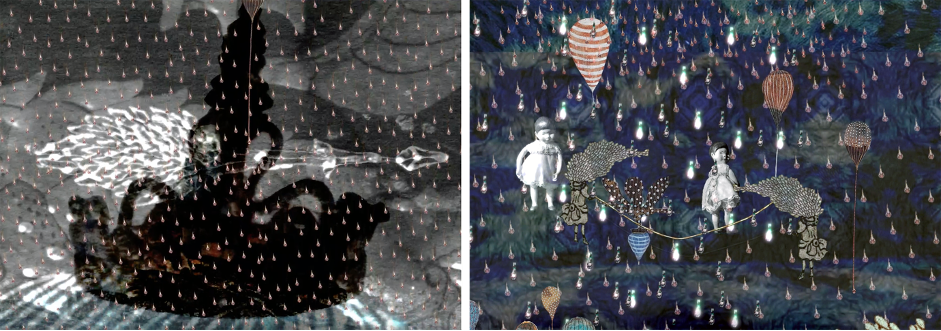
What has been the most challenging aspect of merging traditional art methods with digital technologies, and how have you overcome these challenges?
My artistic journey, blending traditional art with digital technologies, has been marked by challenges and learning, particularly in balancing time-honored techniques with digital advancements. Rooted in foundational art practices like printmaking, photography, and drawing, I’ve maintained these core principles despite the shift towards digital tools.
Blending new technologies with traditional methods, I strive to create unique experiences for audiences, continuously exploring and integrating cutting-edge technology that complements my style. My time at Carnegie Mellon University was pivotal, shifting from a solo approach to embracing collaboration. The project-based structure there honed my teamwork skills, optimizing production processes, and facilitating knowledge exchange.
This educational experience exposed me to emerging technologies and organizational skills, crucial for researching and exploring new fields. The transition from working alone to collaborating in a community has significantly shaped my artistic development, maintaining a balance between my artistic roots and contemporary digital practices.
As a pioneer in this interdisciplinary field, what are your long-term goals or visions for the future of mixed reality and immersive experiences in the art world?
I aim to shape the immersive experience landscape with meaningful VR/AR content. My education at Carnegie Mellon University emphasized creating ethically conscious content, steering clear of violence and explicitness.
My focus is on ethical creativity, ensuring my work positively impacts audiences and aligns with my values, contributing to an inclusive digital environment. I’m exploring emerging technologies like holographic processes to create immersive, emotional experiences featuring fantastical creatures and intricate virtual landscapes.
I use diverse mediums, including e-textiles, 3D printing, and kinetic arts, to foster interactivity and engagement in my narratives. I prioritize developing rich backstories and emotional depth in my art, striving for impactful, innovative experiences.
My goal is to connect with a broad audience, sharing unique insights and enriching lives through my artistic journey.
Could you describe your creative process when starting a new project that combines elements of both traditional and digital art?
My creative process blends sensory experiences—sight, smell, taste, touch, and sound—with childhood memories, merging these with current experiences in my art. This results in a mix of past and present, expressed across various media.
My art creates ethereal realms, evoking nostalgia and weaving ancient memories with new discoveries. It transports viewers to imagined landscapes, populated by imaginary creatures, enriching the narrative with depth and significance.
I’m committed to eliciting emotions and inspiring reinterpretations in my audience, continuously exploring new techniques and technologies to evolve my artistic expressions.
Key aspects of my creative approach include:
- Conceptualization: Brainstorming narratives through sketches or mood boards, informed by the capabilities of technology like mixed reality and 3D modeling.
- Technology Familiarity: Proficiency in software for 3D modeling, mixed reality tech, AR/VR hardware, and projection mapping is vital.
- Storytelling: Crafting compelling stories integrates digital and traditional elements.
- User Interaction: Thoughtfully designed interactive experiences engage users via sensors or motion tracking.
- Testing and Prototyping: Iterative testing in mock environments or simulation software refines the installation.
- Optimization: Efficient operations for real-time interactions require optimized models, textures, and code.
- Collaboration: Teamwork among diverse specialists enhances the creative process.
- Documentation and Maintenance: Accurate records are crucial for future maintenance and replication.
Successful digital installations depend on adaptability, creativity, and technical expertise, tailored to each project’s specific goals and audience.

Who or what have been your biggest inspirations or influences in developing your unique style that blends traditional art with digital mediums?
My artistic style draws inspiration from pioneers blending traditional and digital art. Key influences include Philip Beesley, known for his architectural and digital media fusion, and Eva Hesse, whose innovative use of fabric and fiber in sculptures has shaped my tactile material experiments.
I’m captivated by immersive installations that engage audiences with light, space, and sensory elements. Influences from interactive and new media art, along with the broader digital art landscape, guide my exploration in merging tactile and digital realms. My focus is on creating transformative experiences, particularly through projection mapping and spatial utilization.
Lastly, what advice would you give to emerging artists who are interested in exploring mixed reality and immersive experiences but come from more traditional art backgrounds?
For emerging artists venturing into mixed reality and immersive experiences, consider these guiding principles:
- Continuous Research: Stay abreast of developments in your field to build a robust knowledge base.
- Identify Relevant Media: Choose mediums that best express your subject matter for effective communication.
- Storytelling Approach: Frame your content as a narrative for engagement and relatability.
- Define a Theme: Clearly outline your central theme to maintain project focus and coherence.
- Select Appropriate Media: Pick mediums aligned with your theme for impactful communication.
- Production Planning: Organize your work efficiently using outlines, storyboards, or scripts for a smoother workflow.
- Curiosity and Self-Belief: Foster curiosity for new ideas and believe in your ability to overcome challenges.
- Gain Experience: Engage actively in your field through practical projects and exposure to related works.
This framework blends knowledge, creativity, organization, and self-confidence, forming a solid foundation for success in creative or research-based endeavors.
